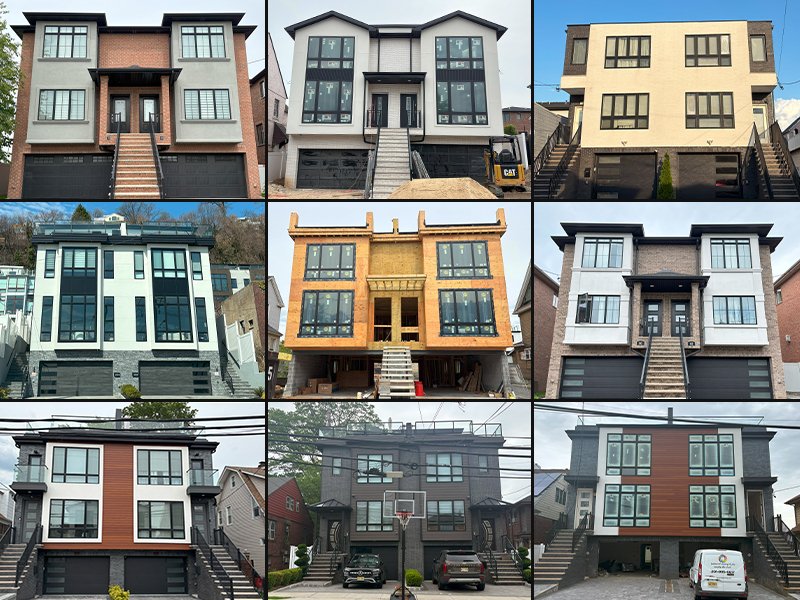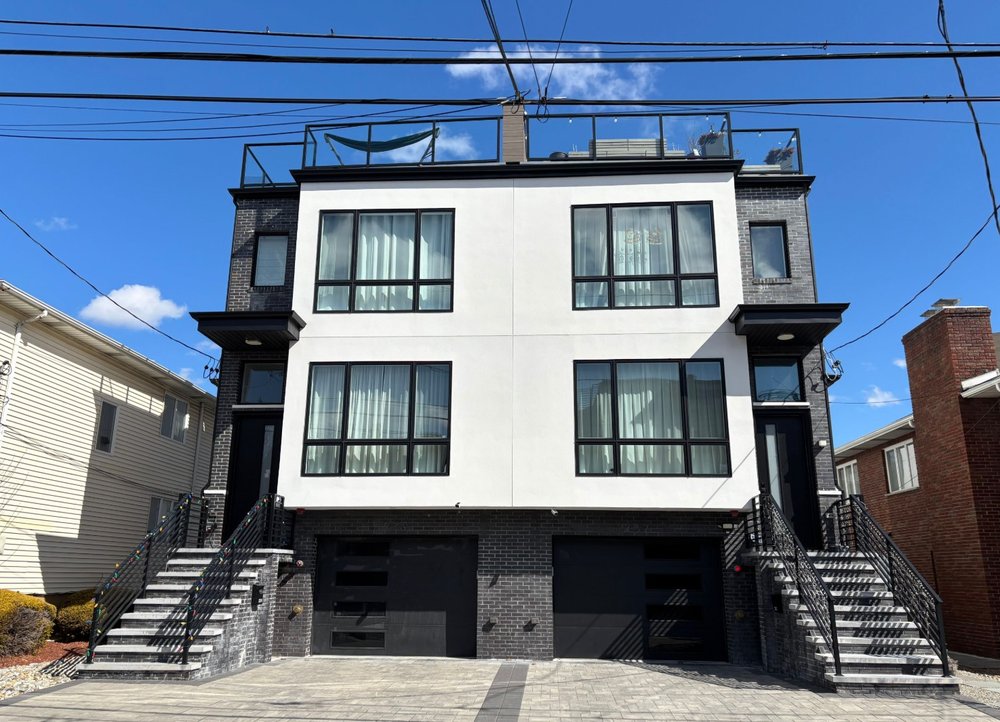Cliffside Cube? A new style duplex is rising in northern NJ. And it’s everywhere.
June 4, 2025, 11 a.m.
The duplexes are replacing traditional, single-family homes in the area. Some residents love them. Others love to hate them. But what should we call them?

Spend enough time in the small New Jersey cities crammed along the Hudson River, between the Lincoln Tunnel and the George Washington Bridge, and you start to see them everywhere: nearly identical modernist duplexes shaped like futuristic cubes. Think South Beach more than south Bergen County.
Their characteristic design — unusual for an area used to brick and clapboard homes — and their hefty price tag aren’t just a symbol of change and increasing urban density in the towns along the Palisades that overlook Manhattan. They’re also part of a land rush, as developers vie to knock down older homes and build new duplexes.
“Everybody, all the developers in this area, they're all looking for the same thing,” said Gregory Garbuz, who runs Fort Lee-based Elite Homes Construction with his father. “Everyone's competing.”
It’s especially true in Cliffside Park, one of the most densely populated towns in the United States, where more than 26,000 people live in less than a square mile across the Hudson River from Morningside Heights. Local land use rules allow property owners to tear down single-family homes and erect the duplexes on many lots. From 2021 to 2023, owners demolished 93 one- and two-family homes in Cliffside Park, state records show. Town officials say those knockdowns often made way for the new duplexes, a template that developers can repeat in a matter of months, and where each unit usually sells for $1 million to $1.5 million.

Some residents say they hate the duplexes, arguing the cookie-cutter structures are out of place and intended to appeal to out-of-town yuppies. Others say they're good for the town, and love what they see as chic, contemporary abodes close to New York City.
Financial consultant Aisha Ozoya moved from Astoria to a Cliffside Park duplex unit with her family two years ago. Ozoya, 35, said she understands the strong reactions some neighbors have to the design, but she likes the space and the rooftop deck overlooking the Manhattan cityscape, with the spire of Riverside Church rising in the foreground.
“ It’s nice, especially at night. You see all the New York lights from the rooftop,” she said.
Do these look familiar?
The boxy, semi-detached homes are everywhere. They come in shades of beige, cream and slate, with four gigantic front windows, and facades of stucco and gray brick, sometimes with smooth wood cladding for added decor. Nearly all of them feature a pair of matte black garage doors, one for each unit, and either a single dark gray staircase dividing the carports, or two sets of stairs that flank the building.

Instead of fully pitched roofs, like the older homes that surround them, the duplexes feature large decks with expansive views of Manhattan. They also come with hardwood flooring, open-concept plans and kitchen islands that developers and real estate agents say attract young urban professionals, many of whom leave New York City for more space.
Despite their ubiquity, however, they’re missing something essential to any architectural trend: a name.
“Cliffside Cubes”
A debate over what to call these love-'em-or-hate-'em duplexes is underway on Reddit. One user dubbed them the “Post-Modern Bayonne Box,” a call-back to another housing style — basically three-story brick rectangles — derided by preservation-minded neighbors in southern Hudson County. Another suggested the “Fort Lee Special” for the preponderance there. A third pointed out that a character from the “Real Housewives of New Jersey” lives in one in Edgewater — “Edgewater Aesthetic,” perhaps? Too clunky.
The duplexes are prevalent in Fort Lee, Palisades Park, Ridgefield and even some parts of Hudson County, like North Bergen.
But there’s a reason for the Cliffside concentration: Current zoning rules there make it easy to replace many single-family homes with duplexes without special approval from the town — unlike some other neighboring cities — as long as the lots are 5,000 square feet. Gothamist counted 25 completed cubes on residential streets in Cliffside Park facing Manhattan on a walk through town last Tuesday, with two more under construction.
The town’s top land use official, Jamie Riggi, declined to weigh in on the design — “it really depends on the person,” she said — but she explained that the new homes are good for the town’s tax base.
“You’re knocking down one- and two-family homes, bringing in duplexes that sell for $1 million, it’s good for revenue,” she said.

Cliffside Park spokesperson Bill Maer said developers began constructing the modern-style duplexes about a decade ago. And while some residents may disagree, he argued that the style of housing is “consistent with the borough’s redevelopment and growth plan.”
Developers filed permits to build seven new duplexes in the first five months of the year, city data shows.
Garbuz, the Fort Lee property developer, keeps a single enlarged photo on the wall above his desk: a cream and gray duplex his company constructed in the same style that’s now everywhere in the area.
He said he’s currently building seven similar homes, one in Fort Lee, one in Palisades Park and the rest in Cliffside Park.
And he said his company uses 36 subcontractors to handle excavation, plumbing, electrical and other jobs. Together, they can demolish the old home and build up the new duplex in nine to 11 months. Older properties are now selling for around $1 million before demolition, but an entire duplex can go for closer to three times that amount.
“We have a really good system put together,” Garbuz said. “It’s like an assembly line.”
Yet, to many neighbors, the duplexes represent unwanted change.
“I don't love them. They look to me like they should be in California on a beach, not in this neighborhood,” said Mary Morales, who has been living in Cliffside Park for 35 years. “I call them the beach houses.”
A few blocks away, Nafiya Hoti, 65, stood in the backyard of her yellow clapboard house. Her home is surrounded by the new duplexes on three of the five lots that border her own. She pointed to an empty wooden home with peeling paint and an overgrown yard catty corner to her own. The home just sold, she said, to a developer planning to build another duplex.
“They're big, giant cubes,” Hoti said. “They’re so bland.”
“Cliffside Cubes,” perhaps? Pretty catchy.
It’s not just a matter of aesthetics. Hoti said the new duplexes are a sign of how the town is becoming more urban, like nearby towns in Hudson County, and expensive.
“It's Cliffside Park becoming a city,” she said.

Housing experts, on the other hand, welcome the kind of development taking place in Cliffside Park and other towns a short bus-ride from the Port Authority. Replacing single-family homes with duplexes, or, in some cases, triplexes adds the kind of “gentle density” needed to address a housing shortage, said Regional Plan Association Vice President Zoe Baldwin.
“ It is a smart move and it's a necessary move because no matter what people's opinions are, the population is increasing,” Baldwin said. “That's a fact. And that means that we need more houses because we have more people.”
Brooklyn leaders say NY can't suspend millions in affordable housing penalties for Atlantic Yards This housing complex is home to 25K New Yorkers. Their costs are about to soar. How a Manhattan bar at the center of a bribery scheme became a hot spot for NYC's political class